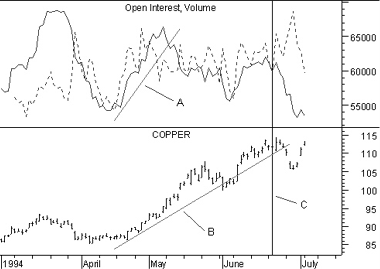
Technical Analysis from A to Z
by Steven B. Achelis
OPEN INTEREST
Overview
Open Interest is the number of open contracts of a given future or option contract. An open contract can be a long or short contract that has not been exercised, closed out, or allowed to expire. Open interest is really more of a data field than an indicator.
A fact that is sometimes overlooked is that a futures contract always involves a buyer and a seller. This means that one unit of open interest always represents two people, a buyer and a seller.
Open interest increases when a buyer and seller create a new contract. This happens when the buyer initiates a long position and the seller initiates a short position. Open interest decreases when the buyer and seller liquidate existing contracts. This happens when the buyer is selling an existing long position and the seller is covering an existing short position.
Interpretation
By itself, open interest only shows the liquidity of a specific contract or market. However, combining volume analysis with open interest sometimes provides subtle clues to the flow of money in and out of the market:
- Rising volume and rising open interest confirm the direction of the current trend.
- Falling volume and falling open interest signal that an end to the current trend may be imminent.
Example
The following chart shows Copper, open interest (the solid line), and volume (the dotted line).

The open interest is for all copper contracts, not just the current contract.
I drew a trendline ("A") when both open interest and volume were increasing. This confirmed the upward trend of prices as shown by the trendline ("B").
I then drew a vertical line ("C") when open interest and volume began to diverge. From this point, volume continued to increase while open interest decreased sharply. This warned of an end to the rising trend.
Contents
- Preface
- Acknowledgments
- Terminology
- To Learn More
- Bibliography
- About the Author
- Technical Analysis
- Price Fields
- Charts
- Support & Resistance
- Trends
- Moving Averages
- Indicators
- Market Indicators
- Line Studies
- Periodicity
- The Time Element
- Conclusion
- Absolute Breadth Index
- Accumulation/Distribution
- Accumulation Swing Index
- Advance/Decline Line
- Advance/Decline Ratio
- Advancing-Declining Issues
- Advancing, Declining, Unchanged Volume
- Andrews' Pitchfork
- Arms Index
- Average True Range
- Bollinger Bands
- Breadth Thrust
- Bull/Bear Ratio
- Candlesticks - Japanese
- CANSLIM
- Chaikin Oscillator
- Commodity Channel Index
- Commodity Selection Index
- Correlation Analysis
- Cumulative Volume Index
- Cycles
- Demand Index
- Detrended Price Oscillator
- Directional Movement
- Dow Theory
- Ease of Movement
- Efficient Market Theory
- Elliott Wave Theory
- Envelopes (Trading Bands)
- Equivolume/Candlevolume
- Fibonacci Studies
- Four Percent Model
- Fourier Transform
- Fundamental Analysis
- Gann Angles
- Herrick Payoff Index
- Interest Rates
- Kagi
- Large Block Ratio
- Linear Regression Lines
- MACD
- Mass Index
- McClellan Oscillator
- McClellan Summation Index
- Median Price
- Member Short Ratio
- Momentum
- Money Flow Index
- Moving Averages
- Negative Volume Index
- New Highs-Lows Cumulative
- New Highs-New Lows
- New Highs/Lows Ratio
- Odd Lot Balance Index
- Odd Lot Purchases/Sales
- Odd Lot Short Ratio
- On Balance Volume
- Open Interest
- Open-10 TRIN
- Option Analysis
- Overbought/Oversold
- Parabolic SAR
- Patterns
- Percent Retracement
- Performance
- Point & Figure
- Positive Volume Index
- Price and Volume Trend
- Price Oscillator
- Price Rate-of-Change
- Public Short Ratio
- Puts/Calls Ratio
- Quadrant Lines
- Relative Strength, Comparative
- Relative Strength Index
- Renko
- Speed Resistance Lines
- Spreads
- Standard Deviation
- STIX
- Stochastic Oscillator
- Swing Index
- Three Line Break
- Time Series Forcast
- Tirone Levels
- Total Short Ratio
- Trade Volume Index
- Trendlines
- TRIX
- Typical Price
- Ultimate Oscillator
- Upside/Downside Ratio
- Upside/Downside Volume
- Vertical Horizonal Filter
- Volatility, Chaikin's
- Volume
- Volume Oscillator
- Volume Rate-of-Change
- Weighted Close
- Williams' Accumulation/Distribution
- Williams' %R
- Zig Zag